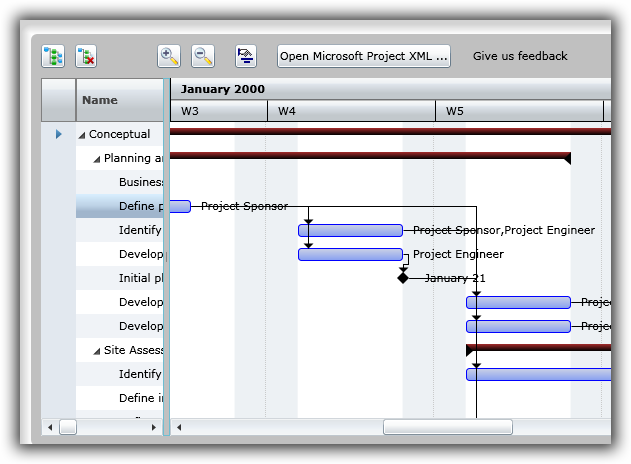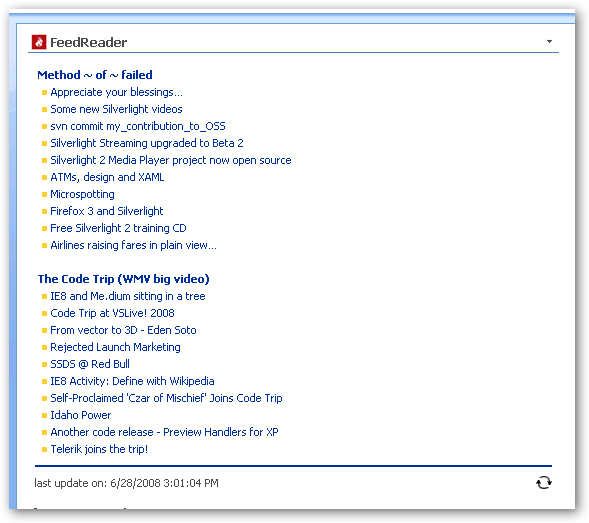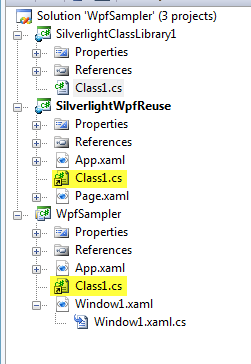1: <Style x:Key="StyledButton" TargetType="Button">
2: <Setter Property="Background" Value="#FF1F3B53"/>
3: <Setter Property="Foreground" Value="#FF000000"/>
4: <Setter Property="Padding" Value="3"/>
5: <Setter Property="BorderThickness" Value="1"/>
6: <Setter Property="BorderBrush">
7: <Setter.Value>
8: <LinearGradientBrush EndPoint="0.5,1" StartPoint="0.5,0">
9: <GradientStop Color="#FFA3AEB9" Offset="0"/>
10: <GradientStop Color="#FF8399A9" Offset="0.375"/>
11: <GradientStop Color="#FF718597" Offset="0.375"/>
12: <GradientStop Color="#FF617584" Offset="1"/>
13: </LinearGradientBrush>
14: </Setter.Value>
15: </Setter>
16: <Setter Property="Template">
17: <Setter.Value>
18: <ControlTemplate TargetType="Button">
19: <Grid>
20: <vsm:VisualStateManager.VisualStateGroups>
21: <vsm:VisualStateGroup x:Name="CommonStates">
22: <vsm:VisualState x:Name="Normal"/>
23: <vsm:VisualState x:Name="MouseOver">
24: <Storyboard>
25: <DoubleAnimationUsingKeyFrames Storyboard.TargetName="BackgroundAnimation" Storyboard.TargetProperty="Opacity">
26: <SplineDoubleKeyFrame KeyTime="0" Value="1"/>
27: </DoubleAnimationUsingKeyFrames>
28: <ColorAnimationUsingKeyFrames Storyboard.TargetName="BackgroundGradient" Storyboard.TargetProperty="(Rectangle.Fill).(GradientBrush.GradientStops)[1].(GradientStop.Color)">
29: <SplineColorKeyFrame KeyTime="0" Value="#F2FFFFFF"/>
30: </ColorAnimationUsingKeyFrames>
31: <ColorAnimationUsingKeyFrames Storyboard.TargetName="BackgroundGradient" Storyboard.TargetProperty="(Rectangle.Fill).(GradientBrush.GradientStops)[2].(GradientStop.Color)">
32: <SplineColorKeyFrame KeyTime="0" Value="#CCFFFFFF"/>
33: </ColorAnimationUsingKeyFrames>
34: <ColorAnimationUsingKeyFrames Storyboard.TargetName="BackgroundGradient" Storyboard.TargetProperty="(Rectangle.Fill).(GradientBrush.GradientStops)[3].(GradientStop.Color)">
35: <SplineColorKeyFrame KeyTime="0" Value="#7FE61212"/>
36: </ColorAnimationUsingKeyFrames>
37: <ColorAnimationUsingKeyFrames BeginTime="00:00:00" Duration="00:00:00.0010000" Storyboard.TargetName="Background" Storyboard.TargetProperty="(Border.Background).(SolidColorBrush.Color)">
38: <SplineColorKeyFrame KeyTime="00:00:00" Value="#FFEE4B4B"/>
39: </ColorAnimationUsingKeyFrames>
40: </Storyboard>
41: </vsm:VisualState>
42: <vsm:VisualState x:Name="Pressed">
43: <Storyboard>
44: <ColorAnimationUsingKeyFrames Storyboard.TargetName="Background" Storyboard.TargetProperty="(Border.Background).(SolidColorBrush.Color)">
45: <SplineColorKeyFrame KeyTime="0" Value="#FFF40B0B"/>
46: </ColorAnimationUsingKeyFrames>
47: <DoubleAnimationUsingKeyFrames Storyboard.TargetName="BackgroundAnimation" Storyboard.TargetProperty="Opacity">
48: <SplineDoubleKeyFrame KeyTime="0" Value="1"/>
49: </DoubleAnimationUsingKeyFrames>
50: <ColorAnimationUsingKeyFrames Storyboard.TargetName="BackgroundGradient" Storyboard.TargetProperty="(Rectangle.Fill).(GradientBrush.GradientStops)[0].(GradientStop.Color)">
51: <SplineColorKeyFrame KeyTime="0" Value="#D8FFFFFF"/>
52: </ColorAnimationUsingKeyFrames>
53: <ColorAnimationUsingKeyFrames Storyboard.TargetName="BackgroundGradient" Storyboard.TargetProperty="(Rectangle.Fill).(GradientBrush.GradientStops)[1].(GradientStop.Color)">
54: <SplineColorKeyFrame KeyTime="0" Value="#C6FFFFFF"/>
55: </ColorAnimationUsingKeyFrames>
56: <ColorAnimationUsingKeyFrames Storyboard.TargetName="BackgroundGradient" Storyboard.TargetProperty="(Rectangle.Fill).(GradientBrush.GradientStops)[2].(GradientStop.Color)">
57: <SplineColorKeyFrame KeyTime="0" Value="#8CFFFFFF"/>
58: </ColorAnimationUsingKeyFrames>
59: <ColorAnimationUsingKeyFrames Storyboard.TargetName="BackgroundGradient" Storyboard.TargetProperty="(Rectangle.Fill).(GradientBrush.GradientStops)[3].(GradientStop.Color)">
60: <SplineColorKeyFrame KeyTime="0" Value="#3FFFFFFF"/>
61: </ColorAnimationUsingKeyFrames>
62: </Storyboard>
63: </vsm:VisualState>
64: <vsm:VisualState x:Name="Disabled">
65: <Storyboard>
66: <DoubleAnimationUsingKeyFrames Storyboard.TargetName="DisabledVisualElement" Storyboard.TargetProperty="Opacity">
67: <SplineDoubleKeyFrame KeyTime="0" Value=".55"/>
68: </DoubleAnimationUsingKeyFrames>
69: </Storyboard>
70: </vsm:VisualState>
71: </vsm:VisualStateGroup>
72: <vsm:VisualStateGroup x:Name="FocusStates">
73: <vsm:VisualState x:Name="Focused">
74: <Storyboard>
75: <DoubleAnimationUsingKeyFrames Storyboard.TargetName="FocusVisualElement" Storyboard.TargetProperty="Opacity">
76: <SplineDoubleKeyFrame KeyTime="0" Value="1"/>
77: </DoubleAnimationUsingKeyFrames>
78: </Storyboard>
79: </vsm:VisualState>
80: <vsm:VisualState x:Name="Unfocused"/>
81: </vsm:VisualStateGroup>
82: </vsm:VisualStateManager.VisualStateGroups>
83: <Border x:Name="Background" Background="White" BorderBrush="{TemplateBinding BorderBrush}" BorderThickness="{TemplateBinding BorderThickness}" CornerRadius="3"> 84: <Grid Margin="1" Background="{TemplateBinding Background}"> 85: <Border x:Name="BackgroundAnimation" Opacity="0" Background="#FF448DCA"/>
86: <Rectangle x:Name="BackgroundGradient">
87: <Rectangle.Fill>
88: <LinearGradientBrush EndPoint=".7,1" StartPoint=".7,0">
89: <GradientStop Color="#FFFFFFFF" Offset="0"/>
90: <GradientStop Color="#F9FFFFFF" Offset="0.375"/>
91: <GradientStop Color="#E5FFFFFF" Offset="0.625"/>
92: <GradientStop Color="#C6FFFFFF" Offset="1"/>
93: </LinearGradientBrush>
94: </Rectangle.Fill>
95: </Rectangle>
96: </Grid>
97: </Border>
98: <ContentPresenter HorizontalAlignment="{TemplateBinding HorizontalContentAlignment}" Margin="{TemplateBinding Padding}" x:Name="contentPresenter" VerticalAlignment="{TemplateBinding VerticalContentAlignment}" Content="{TemplateBinding Content}" ContentTemplate="{TemplateBinding ContentTemplate}"/> 99: <Rectangle x:Name="DisabledVisualElement" IsHitTestVisible="false" Opacity="0" Fill="#FFFFFFFF" RadiusX="3" RadiusY="3"/>
100: <Rectangle Margin="1" x:Name="FocusVisualElement" IsHitTestVisible="false" Opacity="0" Stroke="#FF6DBDD1" StrokeThickness="1" RadiusX="2" RadiusY="2"/>
101: </Grid>
102: </ControlTemplate>
103: </Setter.Value>
104: </Setter>
105: </Style>





 So on to the resolutions. First, I added authentication.
So on to the resolutions. First, I added authentication.